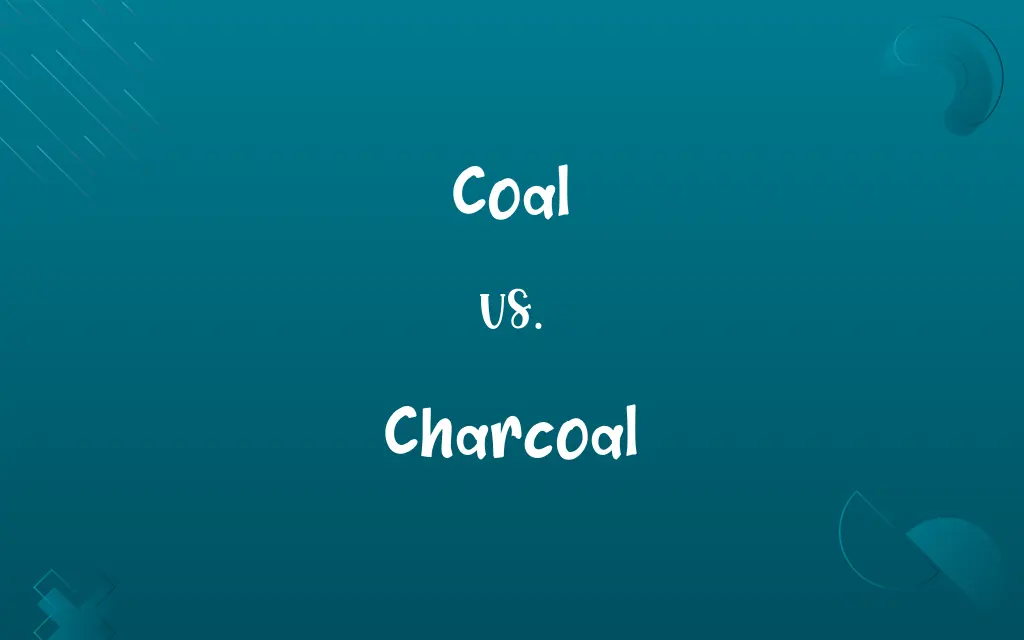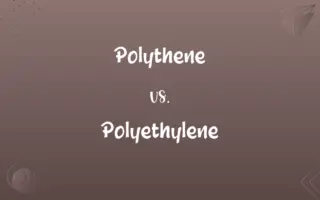Coal vs. Charcoal: Know the Difference

By Shumaila Saeed || Updated on December 25, 2023
Coal is a natural mineral formed from ancient plant matter, used as a fossil fuel, whereas charcoal is a lightweight black carbon residue made by removing water and volatile constituents from organic materials.

Key Differences
Coal is a naturally occurring fossil fuel, formed over millions of years from the remains of decayed plants and animals under high pressure and temperature. Charcoal, in contrast, is a man-made product obtained by burning wood or other organic materials in a low-oxygen environment. Both are carbon-rich substances used as fuel but have different origins and production processes.
Shumaila Saeed
Nov 29, 2023
Coal is categorized into different types like lignite, bituminous, and anthracite based on its carbon content, which affects its energy yield and usage. Charcoal, made from various organic materials, is primarily used for cooking and industrial applications due to its high-temperature burning capability. While both are used for energy, their applications and efficiency vary significantly.
Shumaila Saeed
Nov 29, 2023
The extraction of coal involves mining, which can have environmental impacts like habitat destruction and pollution. Charcoal production, involving controlled burning, can also impact the environment but generally has a smaller ecological footprint. Both coal and charcoal production requires careful management to minimize environmental harm.
Shumaila Saeed
Nov 29, 2023
In terms of pollution, burning coal releases more pollutants, including sulfur and heavy metals, contributing to environmental concerns like acid rain and greenhouse gas emissions. Charcoal, while cleaner-burning, still emits carbon dioxide, but at lower levels compared to coal. Both, however, contribute to air pollution and need to be used responsibly.
Shumaila Saeed
Nov 29, 2023
Economically, coal is a significant source of energy worldwide, driving industrial processes and electricity generation. Charcoal, while also economically important, is more commonly used in smaller-scale applications, such as in barbecues and as an artistic medium. Both play vital roles in their respective domains but with differing scales and impacts.
Shumaila Saeed
Nov 29, 2023
ADVERTISEMENT
Comparison Chart
Types/Varieties
Lignite, bituminous, anthracite
Wood charcoal, activated charcoal
Shumaila Saeed
Nov 29, 2023
Environmental Impact
Greater due to mining and pollutants
Lesser, but still impactful
Shumaila Saeed
Nov 29, 2023
Primary Uses
Electricity generation, industrial processes
Cooking, industrial applications, art
Shumaila Saeed
Nov 29, 2023
Emission & Pollution
Higher emissions, including sulfur
Lower emissions, primarily carbon dioxide
Shumaila Saeed
Nov 29, 2023
ADVERTISEMENT
Coal and Charcoal Definitions
Coal
Coal is a black or brownish-black sedimentary rock used as a fossil fuel.
The power plant uses coal to generate electricity.
Shumaila Saeed
Nov 29, 2023
Charcoal
Charcoal burns at a higher temperature and cleaner than wood.
Charcoal is preferred for its consistent and high-temperature burn.
Shumaila Saeed
Nov 29, 2023
Coal
Coal is a major energy source for electricity and industrial processes.
Many countries rely heavily on coal for their energy needs.
Shumaila Saeed
Nov 29, 2023
Charcoal
Charcoal is a lightweight, black residue made by burning organic materials.
The artist used charcoal for her detailed sketches.
Shumaila Saeed
Nov 29, 2023
Coal
Coal varies in type, including lignite, bituminous, and anthracite.
Anthracite coal burns hotter and cleaner than other types.
Shumaila Saeed
Nov 29, 2023
ADVERTISEMENT
Charcoal
Charcoal comes in various forms, including activated charcoal.
Activated charcoal is used for water purification and gas masks.
Shumaila Saeed
Nov 29, 2023
Coal
A natural dark brown to black graphitelike material used as a fuel, formed from fossilized plants and consisting of amorphous carbon with various organic and some inorganic compounds.
Shumaila Saeed
Oct 19, 2023
Charcoal
A black, porous, carbonaceous material, 85 to 98 percent carbon, produced by the destructive distillation of wood and used as a fuel, filter, and adsorbent.
Shumaila Saeed
Oct 19, 2023
Charcoal
Impure carbon obtained by destructive distillation of wood or other organic matter, that is, heating it in the absence of oxygen. Category:en:Carbon
Shumaila Saeed
Oct 19, 2023
Coal
(uncountable) A black or brownish black rock formed from prehistoric plant remains, composed largely of carbon and burned as a fuel.
The coal in this region was prized by ironmasters in centuries past, who mined it in the spots where the drainage methods of the day permitted.
Shumaila Saeed
Oct 19, 2023
Coal
(countable) A type of coal, such as bituminous, anthracite, or lignite, and grades and varieties thereof, as a fuel commodity ready to buy and burn.
Put some coal on the fire.
Order some coal from the coalyard.
Shumaila Saeed
Oct 19, 2023
Coal
(countable) A piece of coal used for burning this use is less common in American English
Put some coals on the fire.
Shumaila Saeed
Oct 19, 2023
Coal
(countable) A glowing or charred piece of coal, wood, or other solid fuel.
Just as the camp-fire died down to just coals, with no flames to burn the marshmallows, someone dumped a whole load of wood on, so I gave up and went to bed.
Shumaila Saeed
Oct 19, 2023
Charcoal
Impure carbon prepared from vegetable or animal substances; esp., coal made by charring wood in a kiln, retort, etc., from which air is excluded. It is used for fuel and in various mechanical, artistic, and chemical processes.
Shumaila Saeed
Oct 19, 2023
Charcoal
Finely prepared charcoal in small sticks, used as a drawing implement.
Shumaila Saeed
Oct 19, 2023
Charcoal
A carbonaceous material obtained by heating wood or other organic matter in the absence of air
Shumaila Saeed
Oct 19, 2023
Coal
A thoroughly charred, and extinguished or still ignited, fragment from wood or other combustible substance; charcoal.
Shumaila Saeed
Oct 19, 2023
Coal
A black, or brownish black, solid, combustible substance, dug from beds or veins in the earth to be used for fuel, and consisting, like charcoal, mainly of carbon, but more compact, and often affording, when heated, a large amount of volatile matter.
Shumaila Saeed
Oct 19, 2023
Coal
To burn to charcoal; to char.
Charcoal of roots, coaled into great pieces.
Shumaila Saeed
Oct 19, 2023
Charcoal
Charcoal is produced through pyrolysis, eliminating water and volatile substances.
Charcoal is made by heating wood in the absence of air.
Shumaila Saeed
Nov 29, 2023
Coal
Fossil fuel consisting of carbonized vegetable matter deposited in the Carboniferous period
Shumaila Saeed
Oct 19, 2023
Charcoal
Charcoal is used for cooking, especially in barbecues.
They used charcoal to grill the burgers at the picnic.
Shumaila Saeed
Nov 29, 2023
Coal
A hot glowing or smouldering fragment of wood or coal left from a fire
Shumaila Saeed
Oct 19, 2023
Coal
Burn to charcoal;
Without a drenching rain, the forest fire will char everything
Shumaila Saeed
Oct 19, 2023
Coal
Coal is formed from decayed plant matter under high pressure and heat.
Coal mines extract the mineral from deep underground.
Shumaila Saeed
Nov 29, 2023
Coal
Coal mining can have significant environmental impacts.
The region's landscape was altered due to extensive coal mining.
Shumaila Saeed
Nov 29, 2023
Repeatedly Asked Queries
How is charcoal made?
Charcoal is made by burning organic materials in low oxygen to remove water and volatiles.
Shumaila Saeed
Nov 29, 2023
What is charcoal?
Charcoal is a man-made, lightweight black carbon residue used as a fuel and in art.
Shumaila Saeed
Nov 29, 2023
How is coal formed?
Coal is formed over millions of years from decayed plants under high pressure and heat.
Shumaila Saeed
Nov 29, 2023
What are the types of coal?
Coal types include lignite, bituminous, and anthracite, based on carbon content.
Shumaila Saeed
Nov 29, 2023
Is coal renewable?
No, coal is a non-renewable resource as it takes millions of years to form.
Shumaila Saeed
Nov 29, 2023
How does coal impact the environment?
Coal mining and burning can lead to habitat destruction, pollution, and climate change.
Shumaila Saeed
Nov 29, 2023
What is coal?
Coal is a natural, sedimentary fossil fuel used primarily for energy.
Shumaila Saeed
Nov 29, 2023
Is charcoal renewable?
Charcoal can be considered more renewable as it is made from organic materials.
Shumaila Saeed
Nov 29, 2023
What industries use coal?
Coal is used in power generation, steel production, and other industrial processes.
Shumaila Saeed
Nov 29, 2023
Is coal mining dangerous?
Coal mining can be hazardous due to the risk of mine collapses, gas explosions, and lung diseases.
Shumaila Saeed
Nov 29, 2023
What are the uses of charcoal?
Charcoal is used for cooking, industrial processes, and as an artistic medium.
Shumaila Saeed
Nov 29, 2023
What pollutants does coal emit?
Coal emits sulfur, heavy metals, and greenhouse gases when burned.
Shumaila Saeed
Nov 29, 2023
Is charcoal better for cooking than wood?
Charcoal is preferred for cooking due to its higher and more consistent heat output.
Shumaila Saeed
Nov 29, 2023
What pollutants does charcoal emit?
Charcoal primarily emits carbon dioxide when burned, with fewer pollutants than coal.
Shumaila Saeed
Nov 29, 2023
Does coal have different grades?
Yes, coal is graded based on its heat value, sulfur content, and other factors.
Shumaila Saeed
Nov 29, 2023
Can charcoal purify water?
Yes, activated charcoal is used in water purification due to its adsorption abilities.
Shumaila Saeed
Nov 29, 2023
How does charcoal impact the environment?
Charcoal production can contribute to deforestation and air pollution.
Shumaila Saeed
Nov 29, 2023
Can coal be used in art?
Coal is not typically used in art due to its rough texture and brittleness.
Shumaila Saeed
Nov 29, 2023
Can charcoal be used for medical purposes?
Activated charcoal is used in medicine for treating certain poisonings and overdoses.
Shumaila Saeed
Nov 29, 2023
What is activated charcoal?
Activated charcoal is a form of charcoal treated to increase its adsorption properties.
Shumaila Saeed
Nov 29, 2023
Share this page
Link for your blog / website
HTML
Link to share via messenger
About Author
Written by
Shumaila SaeedShumaila Saeed, an expert content creator with 6 years of experience, specializes in distilling complex topics into easily digestible comparisons, shining a light on the nuances that both inform and educate readers with clarity and accuracy.









































































